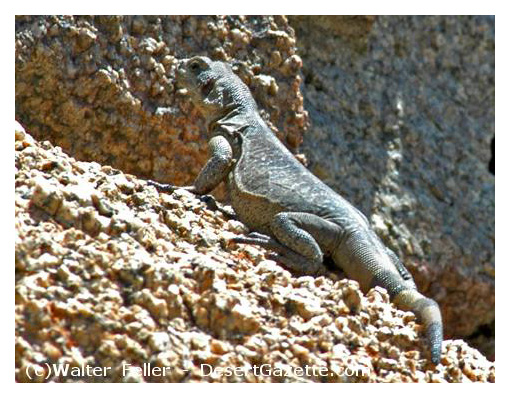Denizens
The Chuckwalla
(Sauromalus ater)This morning "old man chuckwalla" came out of his winter hiding looking as wrinkled and shriveled as a withered apple. His black beadyskin hung on him in folds like the hide of an old elephant, and, as he clumsily clambered upon a big flat red rock and blinked his sleepy eyes in the sun, he appeared to have emerged from his winter torpor with only woe as his portion and without a sign to show that he could appreciate the new awakening spirit of spring. The brownshouldered lizards had been sporting about playing tag with one another in the sun for over a month or more, the rock wrens had been making love flirtations for a fortnight. Even a few hairy caterpillars had ventured forth to feed days ago, risking being gobbled up by the voracious black-throated sparrows. The chuckwalla comes forth among the most belated of all the season's guests.

But wait — there is good reason for his tardiness. He, you must remember, is a feeder on tender buds and blossoms, and why should he come to the feast before it is set? Many of the lizards can live on insects, but he must wait until the flowers have unfurled, and this is usually somewhat advanced in the season's cycle. The elixir vitcB that brings rejuvenescence to the wrinkled body is found in the petals of the flowers that come with the suns of March. To arrive before would be to come to an empty table. Homely, clumsy, stolid, unfinished-looking, and awkward of limb, yet he is the daintiest of feeders — and behind those sleepy eyes lies wisdom.
Not to mention the Gila Monster, the chuckwalla is our largest iguanid lizard, a full-grown individual attaining a length of eighteen inches. The general coloration of the body is brownish black or gray with darker cross-bars, these latter being most clearly defined in young specimens. The blunt tail is usually mottled or marbled with white. In rare instances it is entirely white. "It is a curious fact, however," says Dr. Merriam, "that the distinctness — or even the presence or absence — of these crossbars, especially on the tail, is changeable in the same individual, and apparently dependent on the intensity of light to which the animal is exposed."
Every part of the body is built for a purpose. Though it appears queer in form, yet a study of it will reveal that the chuckwalla is encumbered with none of those useless and over-exaggerated specialized structures which have so often marked senescence among reptiles. The clumsy, fat, blunt tail is his chief weapon of defense, and he can flop it vigorously when occasion demands that he use it. The smart blows he gives cause all his enemies to take notice of him. He looks lazy and stupid, but approach him and see how quickly his short, stubby limbs enable him to drop out of sight and into a place of safety. The flat body makes it possible for him to squeeze himself into extremely narrow cracks in the rocks, and because of his loose, elastic skin he is able to ;inflate himself so tightly that not the strongest man can pull him out from his place of safety. Rather will he surrender his tail to Cerberus than give up his body to his enemy. The lizard-eating Indians, the Shoshones, Cahuillas, and their near cousins the Piutes, however, got the better of him; for they were accustomed to carry with them a sharppointed, hooked stick, and when they saw a chuckwalla which they wanted for food they punctured his inflated hide, and, against his will, pulled him out of his retreat.
The Indians prepared chuckwallas for eating by roasting them over a bed of coals. There is no reason to believe that the white flesh is not palatable.
Chuckwallas are rupestrine lizards generally living around dark rocks, such as iron-stained granites or lavas. They are frequent in almost all the lower desert ranges from southwestern Utah and southern Nevada westward to the Death Valley region and southward to Lower California.
Much of interest concerning the life-history of this remarkable lizard awaits some patient observer who will watch chuckwallas, not in a cage, but in their native home. Who will tell us the age they attain? Where do they lay their eggs? What are their breeding habits?
Chuckwalla
The name chuckwalla (or chuckawalla) is derived from the Shoshone word "tcaxxwal" or "caxwal," the form used by the Cahuilla Indians of southeastern California and originally written in Spanish as "chacahuala."